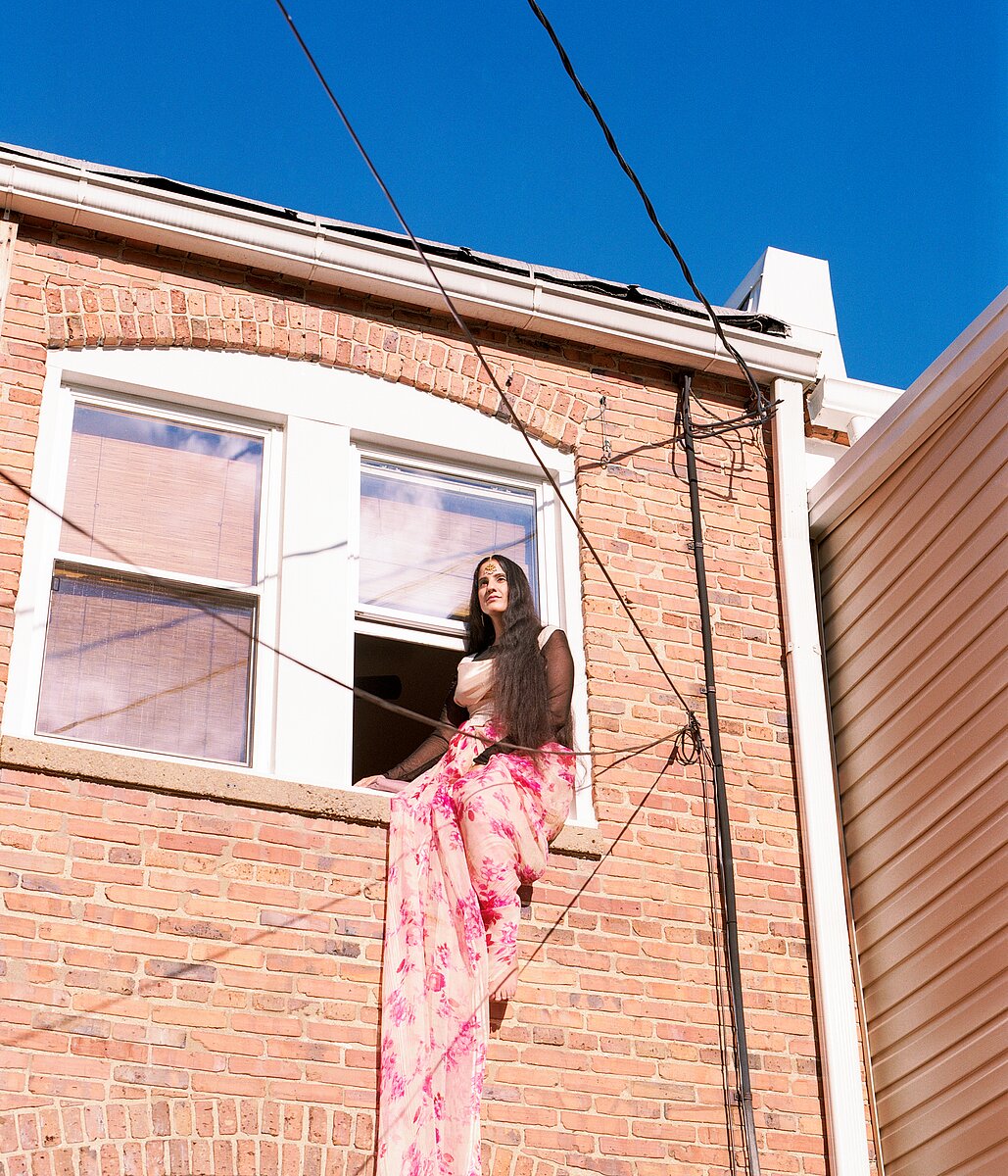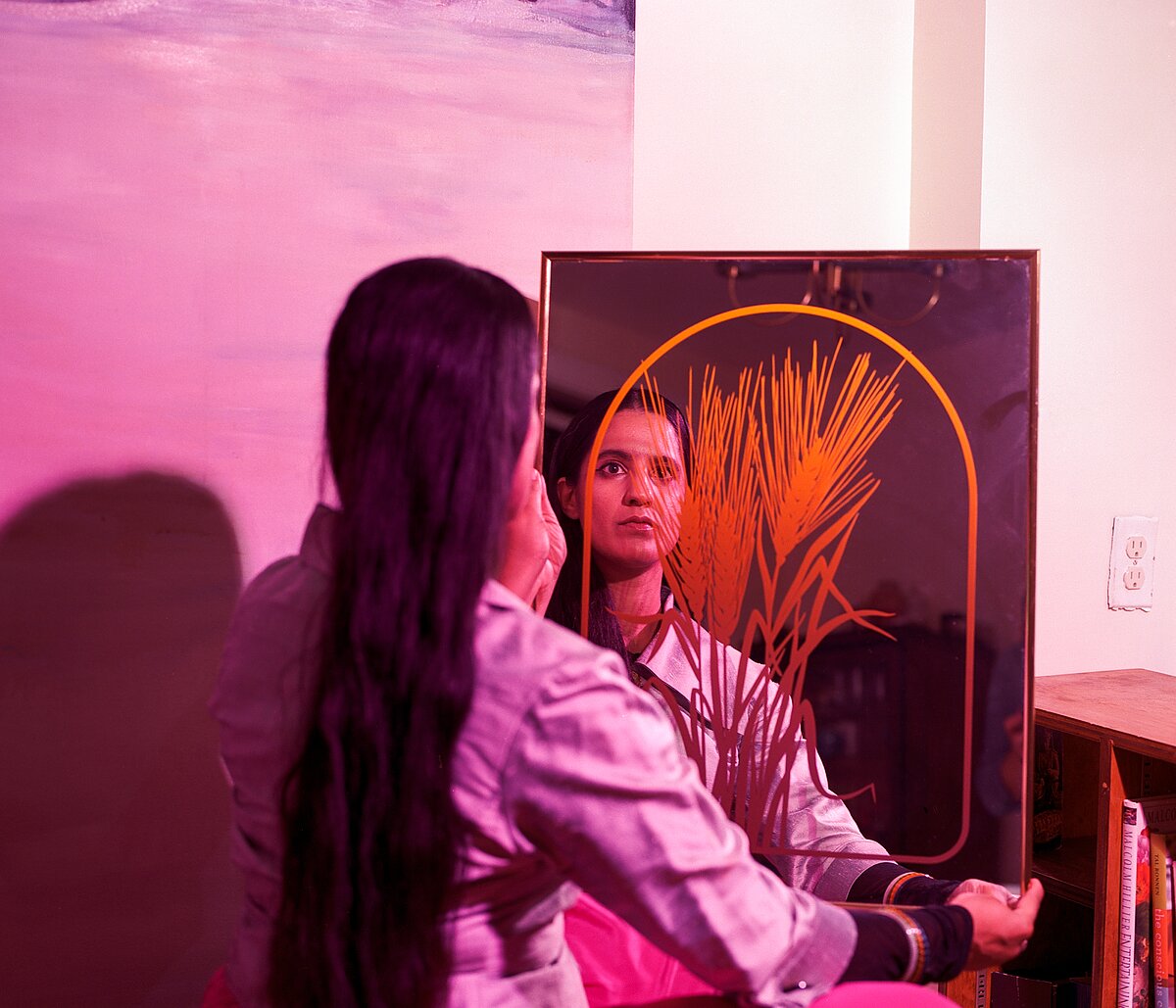Musician Ami Dang Channels Rage and Dismay Into a Call to Mobilize
This past November at Brooklyn’s National Sawdust, 38-year-old composer and singer Ami Dang played a set of enveloping electronic, psychedelia-tinged songs that dipped in and out of a flow state, her sitar galloping and intermingling with the percussion and synth on an atomic level. She wore a bright red lehenga made from an old sari that belonged to her mother, and her middle-parted, hip-length hair almost touched the ground as she sat down to perform. Dang and the musicians she shared the stage with created the kind of electric, humming ambiance that makes the hair on your arms stand up, heightens your senses, and keeps pace with the whirring of your heartbeat.
The day after her performance, Dang and I met at Goldie’s, a dimly-lit bar in Greenpoint, Brooklyn on a warm but rainy evening. The downpour outside was so heavy that it felt like raindrops were falling at you horizontally, and the recent end of daylight savings made the 6 PM darkness feel especially heavy. Paintings of stern-looking lions and tigers covered the walls around us.
The bar’s inky ambiance was fitting for a discussion of Dang’s new album, The Living World’s Demands. Though her live performance of the music was life-affirming, the content of the music is decidedly grim. The project is, according to Dang, “a lament to the challenges to which humanity has subjected the world and itself.” Dang’s voice trembles over ominous braids of synth, sitar, and drum as she addresses intimate partner violence, suicidal ideation, and her own desire to become less materialistic. Her music has always featured these instrumental elements, but on this project, they gel to create a consistent sense of foreboding. It’s Dang’s most imposing and self-assured album yet.
The music’s distinctive power comes from the way the droning instrumental fog builds and shifts like smoke filling up a room, and how Dang cascades her vocals. By contrast, her lyrics address the album’s heavy topics obliquely. For example, on “Betting on the Bull,” she asks, “How will you act with the rot that’s in your heart?” The song is meant to critique billionaires who got richer during the pandemic while most people suffered, but could be directed at any number of situations.
Dang is visiting New York City from her home city of Baltimore, where she grew up the youngest of three daughters to parents who immigrated from New Delhi, India in the early 1970s. Every Sunday as a child, she went to a gurdwara, or Sikh temple, which her family was involved in running. In Sikhism, scripture is meant to be set to music. It was within this context that Dang began singing. “I was encouraged to continue because I had a really loud voice,” she said half-jokingly. After dabbling in piano and violin, Dang started sitar and voice lessons when she was 12. She also took ballet, modern dance, and jazz classes.
When she got to Oberlin College’s music conservatory, Dang realized that the program heavily prioritized the Western canon. In order to incorporate any elements of Indian music into her studies, she had to “be in a program where there were no rules.” She found that freedom in electronic music.
In our conversation, Dang expressed the experience of feeling stuck between conflicting worlds quintessentially felt by children of immigrants. For Dang, it often seemed like she couldn’t truly thrive in any environment because she didn’t wholly embody any one culture. At some point, however, she decided that this experience of misplacement could actually lead to exciting cultural synthesis. She began to see occupying this third space as a unique freedom. “If I can’t win, I’m going to do whatever I feel like doing,” she said. “I’m interested in advancing culture and being a culture-maker and a change-maker.”
Dang wants her music to stand on its own, the result of her unique perspective, rather than an iteration of any practice that came before her. “I’m not interested in it being hyper-traditional,” she told me. “It annoys me sometimes when people apply that label of my work being ‘rooted in Indian classical music.’ Really, my music is very much an American product. It’s a product of being someone who was born and raised here by immigrant parents and was exposed to Bollywood at home and Top 40 with my friends.”
Her new album relays a distinctly contemporary American sense of fatigue and disillusionment, too. Though some of the songs were started as long as 10 years ago, all of them were reworked and fully realized during the pandemic. “These songs have been in the works from Bush to Obama to Trump,” she said. “They could have come out when Trump got elected. But when the pandemic happened, I thought, ‘Maybe this is the breaking point. Maybe people are going to start caring about each other.’ When that didn’t happen, I was like, ‘Who are we as humanity if we don’t want to support each other?’ I became much more cynical because I’ve seen how little change has happened.”
Dang was also motivated to make something darker to avoid being typecast. Her last project, Meditations Mixtape Vol. 1, was a collection of prayers and vocal meditations released in the beginning of the pandemic. “I don’t want to be pegged as a new age artist, so I don’t want to put out another truly ambient album right now,” she stated. “As a sitarist and as someone who has an Indian classical background, it’s easy for people to think of my music as soothing. I can do that as an artist, but I don’t need to do that all the time. I don’t have a mission to make music specifically for yoga and wellness.”
Dang’s music is rooted in a much more personal form of spirituality. She sees music, especially live performances, as more than just entertainment, but also as a means for experiencing transcendence, a kind of emotional awakening that is inspirational and motivational.
Though the music is decidedly tempestuous, there are moments on the album where light peaks through. On “Oh Dha Ta Na,” Dang’s voice is vibrant and elastic. As the song progresses and her delivery speeds up, you feel enlivened, like on the first day of spring when it’s warm enough to walk out your door without a jacket. Similarly, “A Muted Crime,” a song addressing someone who is experiencing intimate partner violence, contains a fierce mobilizing call: “Electrify! Break from your pyre. Fear not now.” In a way, Dang’s music creates a feedback loop between despair and hope–the act of articulating and sharing her dismay with a room full of people creates a pathway toward mobilization and transcending.
–Vrinda Jagota is a writer living in Brooklyn. Her interests include, in no particular order, South Asian American music, Taylor Swift, and trying to understand why everyone started self-identifying as an empath a few years ago.


